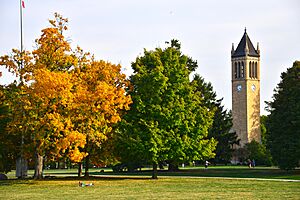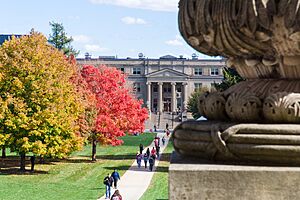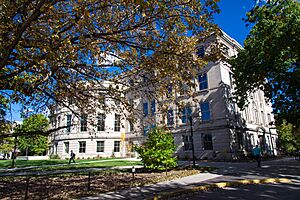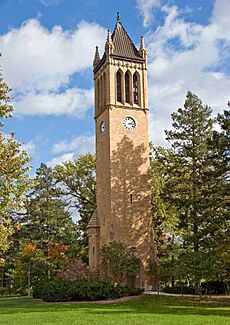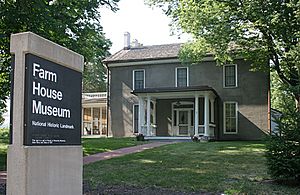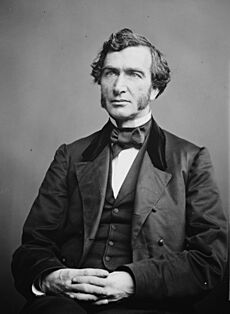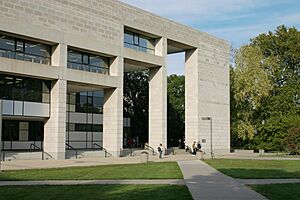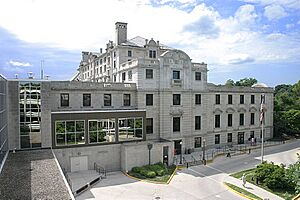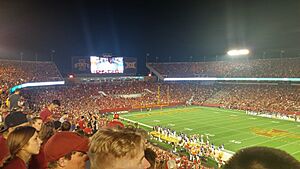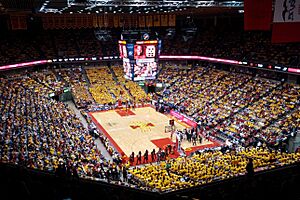Iowa State University facts for kids
|
Iowa State University of Science and Technology
|
|
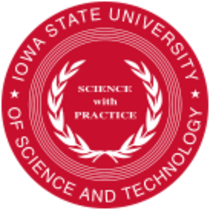 |
|
|
Former names
|
Iowa Agricultural College and Model Farm (1858–1898) Iowa State College of Agriculture and Mechanic Arts (1898–1959) |
|---|---|
| Motto | "Science with Practice" |
| Type | Public land-grant research university |
| Established | March 22, 1858 |
|
Parent institution
|
Iowa Board of Regents |
| Accreditation | HLC |
|
Academic affiliations
|
|
| Endowment | $1.88 billion (2023) |
| President | Wendy Wintersteen |
| Provost | Jason Keith |
|
Academic staff
|
1,746 (2023) |
| Students | 30,432 (Fall 2024) |
| Undergraduates | 25,628 (Fall 2024) |
| Postgraduates | 4,170 (Fall 2024) |
|
Other students
|
634 (Fall 2024) |
| Location |
,
,
United States
42°01′34″N 93°38′53″W / 42.0262°N 93.6480°W |
| Campus | Small city, 1,813 acres (7.34 km2) |
| Newspaper | Iowa State Daily |
| Colors | Cardinal and gold |
| Nickname | Cyclones |
|
Sporting affiliations
|
NCAA Division I FBS – Big 12 |
| Mascot | Cy the Cardinal |
 |
|
Iowa State University (often called Iowa State or ISU) is a large public university in Ames, Iowa. It's known as a "land-grant" university, which means it was created to teach practical subjects like farming and engineering to everyone.
Founded in 1858, it was first called the Iowa Agricultural College and Model Farm. In 1862, Iowa State became one of the first land-grant schools in the United States. It officially became Iowa State University of Science and Technology in 1959.
Today, Iowa State is the second-largest university in Iowa. It offers many different study programs, from science and engineering to design and business. The university is also a top research school, working on many important projects. Its sports teams, the Cyclones, compete in Division I and are part of the Big 12 Conference.
Contents
History of Iowa State
Iowa State University started on March 22, 1858. It was first called the Iowa Agricultural College and Model Farm. The school was built in Story County on a large piece of land.
Iowa was the first state to accept the Morrill Act of 1862. This act gave land to states to create colleges that would teach agriculture and mechanical arts. Iowa State was chosen as the state's land-grant college in 1864. This meant the university would focus on making higher education available to everyone. It would also teach useful subjects alongside traditional ones.
The university welcomed both male and female students from its very first class in 1868. The first students graduated in 1872.
The first building on campus was The Farm House, finished in 1861. It was home to the farm superintendent and later, important agriculture leaders. Iowa State's first president, Adonijah Welch, even wrote his first speech there.
Iowa State was a leader in education. In 1870, professors held special "farmers' institutes" away from campus. These were early examples of how universities shared knowledge with communities. In 1872, Iowa State was the first land-grant university to offer classes in domestic economy (now called home economics or human sciences) for college credit. In 1879, it started the first state veterinary college in the U.S.
Growth and New Name
When William Miller Beardshear became president in 1891, Iowa State grew a lot. He added new programs and hired great teachers. Many important buildings were built during his time, like Morrill Hall (1891) and the Campanile (1899). In 1898, the school's name changed to Iowa State College of Agricultural and Mechanic Arts.
Today, Beardshear Hall holds the main offices for the university's leaders. Carrie Chapman Catt Hall is named after a famous Iowa State graduate who fought for women's right to vote. It is home to the College of Liberal Arts and Sciences.
Iowa State held its first Homecoming celebration in 1912. This event brings alumni (former students) back to campus, often for a football game.
The university also had a big annual festival called VEISHEA. It started in 1922 and was named using the first letters of the university's original colleges: Veterinary Medicine, Engineering, Industrial Science, Home Economics, and Agriculture. VEISHEA was a huge student-run festival that attracted many visitors. However, it was retired as an annual event in 2014.
In 1933, the Statistical Laboratory was created. It was the first research and consulting center of its kind in the country.
Birthplace of the Digital Computer
Iowa State is famous as the birthplace of the first electronic digital computer. In 1937, mathematics and physics professor John Vincent Atanasoff and graduate student Clifford Berry created the Atanasoff–Berry Computer (ABC). This computer used new ideas that are still important in computers today. A working replica of the ABC is on display at the Durham Computation Center on campus.
On July 4, 1959, the college officially became Iowa State University of Science and Technology. The university has continued to grow and is known for its research programs.
Iowa State's Role in the Manhattan Project
Iowa State played a secret but important role during World War II as part of the Manhattan Project. This project was about developing the atomic bomb. Scientists at Iowa State created a special way to produce large amounts of very pure uranium metal. This method became known as the "Ames process." A significant amount of the uranium used in the world's first controlled nuclear chain reaction was made at Iowa State. Today, Iowa State is the only university in the U.S. with a U.S. Department of Energy research lab right on its campus.
Exploring the Campus
Iowa State's campus has over 160 buildings. Many of them, including the Marston Water Tower, are listed as historic places. The central part of campus is about 490 acres, filled with trees, plants, and classic buildings. The main feature is a 20-acre central lawn, which is recognized as a beautifully designed landscape.
The Campanile
The Campanile is a tall bell tower built between 1897 and 1898. It was built to honor Margaret MacDonald Stanton, Iowa State's first dean of women. The tower is 110 feet tall and cost about $6,510 to build. It is a major symbol of Iowa State University and is even featured on the university's official ring.
Lake LaVerne
Lake LaVerne is a small lake on campus, named after LaVerne W. Noyes, a graduate who donated money to help finish Alumni Hall. The lake is home to two mute swans named Sir Lancelot and Elaine. These swans are a beloved part of the campus. The current Sir Lancelot and Elaine are both female, as the university supports efforts to re-establish trumpeter swans in Iowa.
Reiman Gardens

Iowa State has had horticulture gardens since 1914. Reiman Gardens is the current location, started in 1993 with a gift from Bobbi and Roy Reiman. The gardens officially opened in 1995 and have grown to 14 acres. They include many different garden areas, an indoor conservatory, and an indoor butterfly "wing." Reiman Gardens is open year-round and is a popular attraction in central Iowa. Its rose gardens have won national awards for their beauty and care.
University Museums
Iowa State has several university museums: the Brunnier Art Museum, Farm House Museum, the Art on Campus Program, the Christian Petersen Art Museum, and the Elizabeth and Byron Anderson Sculpture Garden.
Brunnier Art Museum
The Brunnier Art Museum is Iowa's only museum that focuses on decorative arts, like ceramics, glass, and dolls. It was founded in 1975 and named after Henry J. Brunnier and his wife Ann, who donated their collection. The museum also displays other art objects from the university's collection.
Farm House Museum
The Farm House Museum is a National Historic Landmark located near the center of campus. It was the very first building on campus, built in 1860. It served as a home for early farm tenants and important university figures. In 1976, the Farm House became a museum. It shows what life was like in early Iowa State history, with collections of 19th and early 20th-century decorative arts and furnishings.
Art on Campus Collection
Iowa State has one of the largest public art programs on a university campus in the United States. There are over 2,000 pieces of public art all around campus, in buildings, courtyards, and open spaces. This program started in the 1930s. Famous artists like Grant Wood and Christian Petersen created art for the campus.
Christian Petersen Art Museum
The Christian Petersen Art Museum is in Morrill Hall. It's named after Christian Petersen, who was the first permanent artist-in-residence at Iowa State from 1934 to 1955. He created many sculptures for the campus. Morrill Hall itself was built in 1891 and was renovated to become the museum in 2007.
Anderson Sculpture Garden
The Elizabeth and Byron Anderson Sculpture Garden is next to the Christian Petersen Art Museum. It's an outdoor space with sculptures, plants, and pathways. It features modern and contemporary sculptures, mostly by American artists.
Sustainability Efforts
Iowa State is committed to being environmentally friendly. It has a large composting facility that can process over 10,000 tons of organic waste each year. The university also has a special fund that loans money for projects that save energy on campus.
Academics at Iowa State
| College/school founding | |
|---|---|
| College/school |
|
|
|
|
| College of Agriculture and Life Sciences |
|
| College of Veterinary Medicine |
|
| College of Engineering |
|
| Graduate College |
|
| College of Liberal Arts & Sciences |
|
| College of Design |
|
| Ivy College of Business |
|
| College of Human Sciences |
|
Iowa State University has eight colleges and two schools. They offer over 100 different bachelor's degree programs, 112 master's programs, and 83 doctoral programs. This includes a special professional degree program in Veterinary Medicine.
Some of the colleges include:
- College of Agriculture and Life Sciences
- College of Veterinary Medicine
- College of Engineering
- College of Liberal Arts & Sciences
- College of Design
- Ivy College of Business
- College of Human Sciences
University Rankings
Iowa State is known as a "Doctoral University – Very High Research Activity" school. This means it does a lot of research. The university receives nearly $500 million in research grants every year.
In 2020, its agriculture and forestry programs were ranked 16th in the world. The statistics program was tied for 20th in the U.S. in 2018. Iowa State's chemistry and physics programs are also highly ranked.
Parks Library
The W. Robert and Ellen Sorge Parks Library is a huge library with over 2.6 million books and subscriptions to more than 98,600 journals. It's named after W. Robert Parks, the 11th president of Iowa State, and his wife, Ellen Sorge Parks. The library was first built in 1925 and has had several additions over the years.
Inside the library, you can see eight large mural panels created by Iowa artist Grant Wood. These murals show scenes related to agriculture and the founding of Iowa.
Cooperative Extension
Iowa State was a pioneer in sharing its knowledge with communities. It created the first Extension Service in 1902. This service helps people in Iowa with things like farming, family life, and community development. The national extension program, created in 1914, was based on Iowa State's successful model.
Research at Iowa State
Iowa State University is part of several important research groups. In 2020, Iowa State spent $363.1 million on research and development.
Ames National Laboratory
Iowa State is unique because it's the only university in the U.S. with a U.S. Department of Energy research lab right on its campus. This lab, called Ames National Laboratory, is one of ten national DOE Office of Science research labs. It started in the 1940s with Iowa State's work on producing high-purity uranium for atomic energy. Today, it continues to be a leader in materials research.
ISU Research Park
The ISU Research Park was created in 1987. It's a place where new companies and ideas can grow, often based on research done at the university.
Other Research Centers
Iowa State has many other research centers:
- The Biorenewables Research Laboratory opened in 2010. It focuses on research related to renewable resources and creating new products from plants.
- The Engineering Teaching and Research Complex was built in 1999. It houses many engineering departments and includes advanced labs, like one of the world's only six-sided immersive virtual reality labs.
- The Plant Sciences Institute was founded in 1999. It studies plants to understand how their genes and environment affect their traits.
Student Life
| Race and ethnicity | Total | ||
|---|---|---|---|
| White | 77% |
|
|
| Hispanic | 7% |
|
|
| Asian | 4% |
|
|
| Black | 3% |
|
|
| International student | 3% |
|
|
| Two or more races | 3% |
|
|
| Unknown | 2% |
|
|
| Economic diversity | |||
| Low-income | 19% |
|
|
| Affluent | 81% |
|
|
Where Students Live
Iowa State has 20 on-campus residence halls (dorms). These dorms are grouped into different areas. For example, Friley Hall is one of the largest residence halls in the country. There are also apartment complexes for older students.
Student Organizations
ISU has over 900 student organizations! These groups cover many different interests, from academic clubs to hobby groups. Many of these organizations have offices in the Memorial Union.
The Memorial Union opened in 1928. It's a place for students to gather and includes a bowling alley, a book store, and places to eat. It was designed as a memorial for ISU students who died in World War I. The Gold Star Room inside honors veterans from various wars.
Fraternities and Sororities
Iowa State has many fraternity and sorority chapters. These groups involve about 14.6 percent of undergraduate students. Members often raise money for charities and volunteer in the community. The first fraternity at Iowa State was established in 1875, and the first sorority in 1877.
Student Media
Students at Iowa State run their own media outlets:
- The Iowa State Daily is the university's student newspaper. It started in 1890 and has won awards for its journalism.
- 88.5 KURE is the student-run radio station.
- ISUtv is the student-run television station.
Athletics: The Iowa State Cyclones
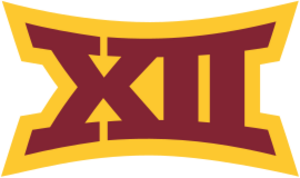
Iowa State's sports teams are called the "Cyclones." This nickname started in 1895 after a football game where a newspaper said the Iowa team played like a "cyclone." The school colors are cardinal and gold. The mascot is Cy the Cardinal, who was introduced in 1954. Since a cyclone is hard to draw as a mascot, a cardinal was chosen because of the school colors.
The Iowa State Cyclones compete in the Big 12 Conference in NCAA Division I. They have 16 different sports teams. Iowa State has a big rivalry with the University of Iowa. They compete each year for the Iowa Corn Cy-Hawk Series trophy.
Football
Football started as a recreational sport at Iowa State in 1878. The first official team was formed in 1892. The Cyclones play their home games at Jack Trice Stadium. This stadium is named after Jack Trice, who was Iowa State's first African-American athlete. He was also the only Iowa State athlete to die from injuries during a game in 1923. The stadium was named in his honor in 1997.
Men's Basketball
The men's basketball team plays at Hilton Coliseum. The team has had many successful seasons, winning conference titles and making it to the NCAA tournament. They reached the "Sweet Sixteen" eight times and the "Elite Eight" twice. In 1944, they even made it to the "Final Four."
Women's Basketball
Iowa State is known for having one of the best women's basketball programs in the country. Under Coach Bill Fennelly, the Cyclones have won conference titles and reached the "Sweet Sixteen" five times and the "Elite Eight" twice in the NCAA tournament. The team has a very large fan base and often ranks among the top in the nation for attendance at games.
Volleyball
The women's volleyball team has also been very successful. They have had many 20-win seasons and have reached the NCAA regional semifinals multiple times. In 2011, they had 25 wins and a national ranking of eighth.
Wrestling
The ISU wrestling program has won the NCAA wrestling tournament title eight times. They also won the Big 12 Conference Tournament three years in a row from 2007 to 2009. In 2010, the Cyclones became the first college wrestling program to win 1,000 dual matches. Famous Iowa State wrestlers include Cael Sanderson, who was an undefeated NCAA champion and Olympic gold medalist, and Dan Gable, who won Olympic gold without giving up a single point.
Notable People
Many famous people have studied or worked at Iowa State University.
See also
 In Spanish: Universidad Estatal de Iowa para niños
In Spanish: Universidad Estatal de Iowa para niños
- Iowa Board of Regents
- CyRide
- List of land-grant universities


